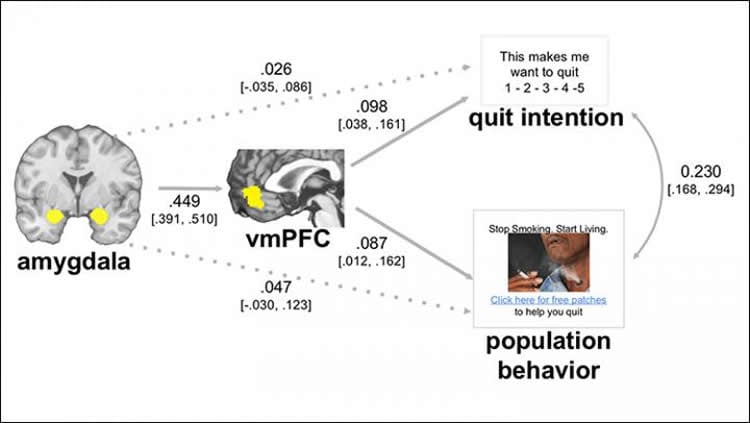Summary: A new neuroimaging study helps researchers predict the response people will have to public health campaigns. The study may help epidemiologists design campaigns to help change people’s attitudes and behaviors.
Source: SfN.
Neuroimaging data obtained from a small group of smokers predicts the influence of a large anti-smoking media campaign targeting likely smokers, shows a new study published in Journal of Neuroscience. This approach could help improve informational materials designed to change people’s attitudes and behaviors.
Bruce Dore, Emily Falk and colleagues identified a neural pathway between the amygdala — which is sensitive to emotional content — and the ventromedial prefrontal cortex that predicted the efficacy of graphic anti-smoking messages.
The images that smokers said made them want to quit were the same ones that encouraged likely smokers to click through for more information in a New York State Smokers’ Quit Line email campaign.

Further, images that elicited higher amygdala and vmPFC activity were also more successful in the email campaign – a relationship that was particularly clear when smokers showed low expression of a pattern of brain activity characteristic of emotion regulation.
Together these results suggest neuroimaging can be used to predict individual- and population-level responses to persuasive health messages.
Funding: The Michigan Center of Excellence in Cancer Communication Research, National Institutes ofHealth, US Army Research Laboratory, NIH/National Cancer Institute, US Food and Drug Administration funded this study.
Source: David Barnstone – SfN
Publisher: Organized by NeuroscienceNews.com.
Image Source: NeuroscienceNews.com image is credited to Doré et al., JNeurosci (2019).
Original Research: Abstract for “Neural mechanisms of emotion regulation moderate the predictive value of affective and value-related brain responses to persuasive messages” by B.P. Doré, S.H. Tompson, M.B. O’Donnell, L. An, V. Strecher and E.B. Falk in Journal of Neuroscience. Published January 7 2019.
doi:10.1523/JNEUROSCI.1651-18.2018
[cbtabs][cbtab title=”MLA”]SfN”Brain Imaging Predicts Response to Public Health Campaign.” NeuroscienceNews. NeuroscienceNews, 7 January 2019.
<https://neurosciencenews.com/neuroimaging-public-health-10437/>.[/cbtab][cbtab title=”APA”]SfN(2019, January 7). Brain Imaging Predicts Response to Public Health Campaign. NeuroscienceNews. Retrieved January 7, 2019 from https://neurosciencenews.com/neuroimaging-public-health-10437/[/cbtab][cbtab title=”Chicago”]SfN”Brain Imaging Predicts Response to Public Health Campaign.” https://neurosciencenews.com/neuroimaging-public-health-10437/ (accessed January 7, 2019).[/cbtab][/cbtabs]
Abstract
Neural mechanisms of emotion regulation moderate the predictive value of affective and value-related brain responses to persuasive messages
Emotionally evocative messages can be an effective way to change behavior, but the neural pathways that translate messages into effects on individuals and populations are not fully understood. We used a human functional neuroimaging approach to ask how affect-, value-, and regulation-related brain systems interact to predict effects of graphic anti-smoking messages for individual smokers (both males and females) and within a population-level messaging campaign. Results indicated that increased activity in the amygdala, a region involved in affective reactivity, predicted both personal quit intentions and population-level information-seeking, and this was mediated by activity in ventromedial prefrontal cortex (vmPFC), a region involved in computing an integrative value signal. Further, the predictive value of these regions was moderated by expression of a meta-analytically defined brain pattern indexing emotion regulation. That is, amygdala and vmPFC activity strongly tracked with population behavior only when participants showed low recruitment of this brain pattern, which consists of regions involved in goal-driven regulation of affective responses. Overall, these findings suggest: i) that affective and value-related brain responses can predict the success of persuasive messages, and ii) that neural mechanisms of emotion regulation can shape these responses, moderating the extent to which they track with population-level message impact.
SIGNIFICANCE STATEMENT
People and organizations often appeal to our emotions in order to persuade us, but how these appeals engage the brain to drive behavior is not fully understood. We present an fMRI-based model that integrates affect-, control-, and value-related brain responses to predict the impact of graphic anti-smoking stimuli within a small group of smokers and a larger-scale public messaging campaign. This model indicated that amygdala activity predicted the impact of the anti-smoking messages, but that this relationship was mediated by vmPFC and moderated by expression of a distributed brain pattern associated with regulating emotion. These results suggest that neural mechanisms of emotion regulation can shape the extent to which affect and value-related brain responses track with population behavioral effects.






